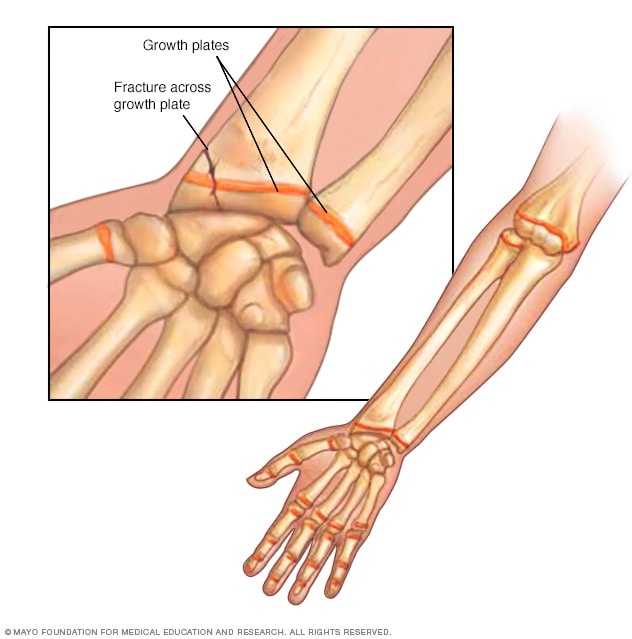Fractures of the growth plate
Fractures of the growth plate
overview
Rupture of the growth plate

Rupture of the growth plate
Growth plates are located near the ends of your child's bones. If a fracture passes through a growth plate, it can result in a shorter or crooked limb.
A growth plate fracture affects the layer of growing tissue near the ends of a child's bones. Growth plates are the softest and weakest sections of the skeleton - sometimes even weaker than the surrounding ligaments and tendons. An injury that could cause a joint sprain in an adult can result in a growth plate fracture in a child.
Growth plate fractures often need to be treated immediately because they can affect bone growth. An improperly treated growth plate fracture can cause a broken bone to become crooked or shorter than its opposite limb. With proper treatment, most growth plate fractures heal without complications.
Symptoms
Most growth plate fractures occur in the bones of the fingers, forearm, and lower leg. Signs and symptoms of a growth plate fracture may include:
- Schmerzen und Empfindlichkeit, insbesondere als Reaktion auf Druck auf die Wachstumsfuge
- Unfähigkeit, den betroffenen Bereich zu bewegen oder Gewicht oder Druck auf die Extremität auszuüben
- Wärme und Schwellung am Ende eines Knochens, in der Nähe eines Gelenks
When to go to the doctor?
If you suspect a broken bone, take your child for a medical examination. Also have your child examined if you notice a visible deformity in your child's arms or legs, or if your child has difficulty playing sports due to persistent pain.
Causes
Growth plate fractures are often caused by a fall or blow to the limb, as can occur with:
- Ein Autounfall
- Leistungssportarten wie Fußball, Basketball, Laufen, Tanzen oder Turnen
- Freizeitaktivitäten wie Radfahren, Rodeln, Skifahren oder Skateboarden
Growth plate fractures can occasionally be caused by overuse, which can occur during sports training or repetitive throwing.
Risk factors
Growth plate fractures occur twice as often in boys as in girls because girls finish growing earlier than boys. By the age of 12, most girls' growth plates have already matured and been replaced by solid bone.
Complications
Most growth plate fractures heal without complications. But the following factors can increase the risk of crooked, accelerated or stunted bone growth.
- Schwere der Verletzung. Wenn die Wachstumsfuge verschoben, zerbrochen oder gequetscht wurde, ist das Risiko einer Gliedmaßendeformität größer.
- Alter des Kindes. Jüngere Kinder haben noch mehr Wachstumsjahre vor sich, wenn also die Wachstumsfuge dauerhaft geschädigt ist, ist die Wahrscheinlichkeit größer, dass sich eine Deformität entwickelt. Wenn ein Kind fast fertig wächst, kann eine dauerhafte Schädigung der Wachstumsfuge nur eine minimale Deformität verursachen.
- Ort der Verletzung. Die Wachstumsfugen um das Knie herum sind anfälliger für Verletzungen. Ein Bruch der Wachstumsfuge am Knie kann dazu führen, dass das Bein kürzer, länger oder krumm wird, wenn die Wachstumsfuge dauerhaft geschädigt ist. Verletzungen der Wachstumsfuge an Handgelenk und Schulter heilen in der Regel problemlos aus.
Sources:
- Verletzungen der Wachstumsfuge. National Institute of Arthritis and Musculoskeletal and Skin Diseases. http://www.niams.nih.gov/Health_Info/Growth_Plate_Injuries. Abgerufen am 29. März 2016.
- Frakturen der Wachstumsfuge. Amerikanische Akademie der orthopädischen Chirurgen. http://orthoinfo.aaos.org/topic.cfm?topic=A00040. Abgerufen am 29. März 2016.
- Mathison DJ, et al. Allgemeine Prinzipien des Frakturmanagements: Frakturmuster und -beschreibung bei Kindern. http://www.uptodate.com/home. Abgerufen am 29. März 2016.
- Kliegman RM, et al. Häufige Frakturen. In: Nelson Lehrbuch der Kinderheilkunde. 20. Aufl. Philadelphia, Pennsylvania: Elsevier; 2016. http://www.clinicalkey.com. Abgerufen am 29. März 2016.
- Marx JA, et al., Hrsg. Allgemeine Grundsätze orthopädischer Verletzungen. In: Rosens Notfallmedizin: Konzepte und klinische Praxis. 8. Aufl. Philadelphia, Pennsylvania: Saunders Elsevier; 2014. http://www.clinicalkey.com. Abgerufen am 29. März 2016.
- Shaughnessy WJ (Expertenmeinung). Mayo Clinic, Rochester, Minnesota, 16. Mai 2016.

 Suche
Suche
 Mein Konto
Mein Konto